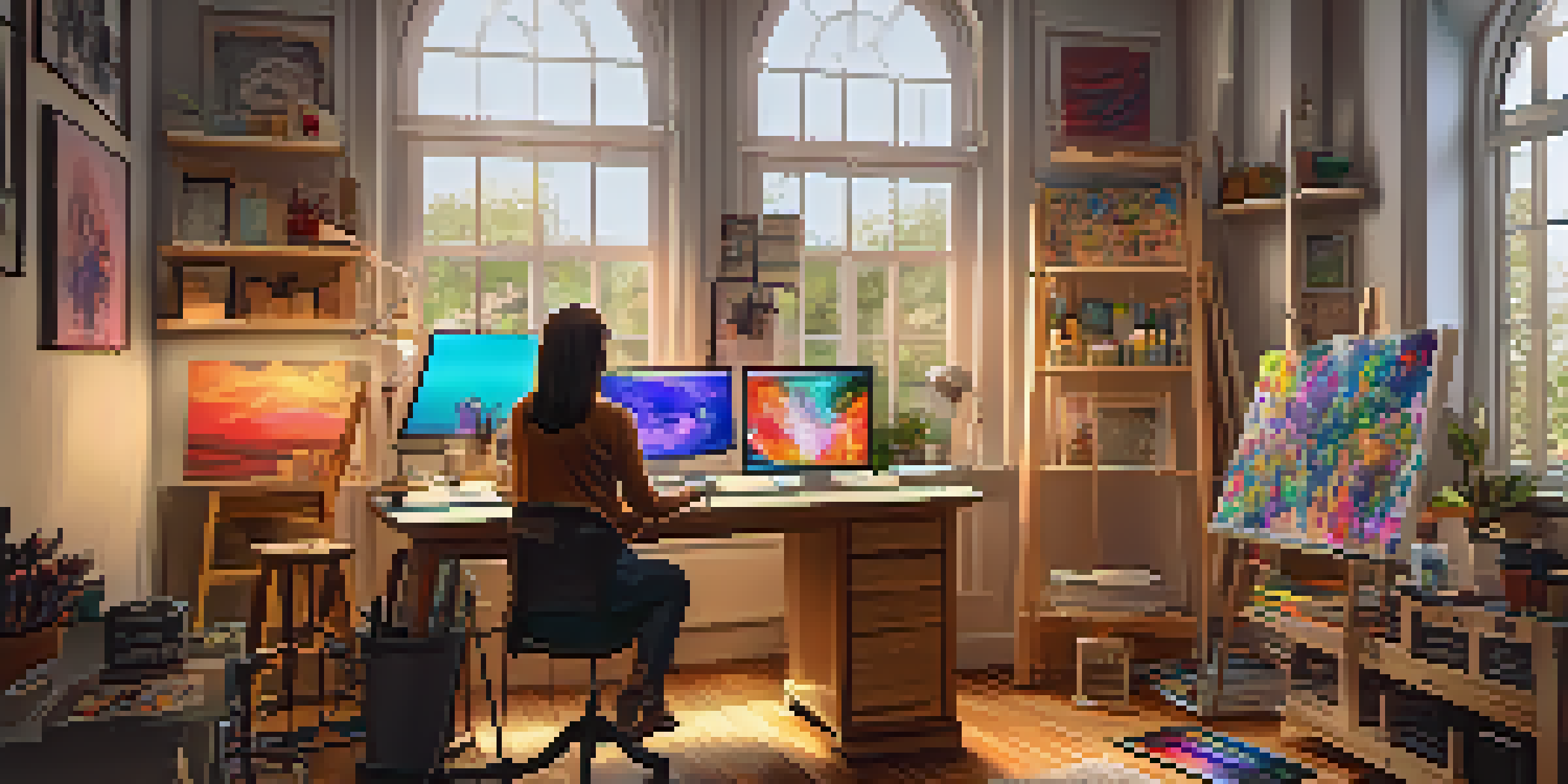NFTs and Intellectual Property: Protecting Digital Creations

Understanding NFTs and Their Role in Digital Art
Non-Fungible Tokens, or NFTs, have revolutionized the way we view and sell digital art. Unlike traditional art, which can be replicated, NFTs represent a unique asset that can be bought and sold. This uniqueness is what gives NFTs their value, making them attractive to artists and collectors alike. By linking digital creations to blockchain technology, NFTs ensure that ownership is transparent and verifiable.
Intellectual property rights are the backbone of creativity and innovation in our society.
Imagine owning a one-of-a-kind painting; that feeling of exclusivity is what NFTs bring to the digital realm. Artists can now monetize their work in new ways, reaching a global audience without the need for intermediaries. As a result, the digital art market has exploded, with some NFTs selling for millions of dollars, showcasing the significant potential for creators.
However, while NFTs offer new opportunities, they also raise questions about ownership and copyright. Artists must navigate this evolving landscape to protect their rights while taking advantage of the benefits NFTs provide.
The Basics of Intellectual Property Rights
Intellectual Property (IP) is a legal concept that protects creations of the mind, including inventions, literary and artistic works, and symbols. It allows creators to control how their work is used, ensuring they can benefit financially from their creations. Understanding IP is crucial for anyone involved in digital art, especially in the NFT space, where ownership rights can be murky.

There are several types of IP protections, including copyrights, trademarks, and patents, each serving different purposes. For artists, copyright is the most relevant, as it automatically protects original works from unauthorized use. However, navigating the complexities of IP law can be daunting, especially for those new to the field.
NFTs Redefine Digital Art Ownership
NFTs offer unique digital assets, allowing artists to monetize their work while ensuring transparent ownership through blockchain technology.
By grasping the fundamentals of IP, artists can better defend their rights in the digital marketplace. This knowledge empowers them to create confidently, knowing they have legal backing should their work be misused.
How NFTs Affect Copyright Ownership
When an artist creates an NFT, it's essential to understand how it interacts with copyright ownership. Simply minting an NFT does not automatically transfer copyright to the buyer; instead, the original creator retains those rights unless explicitly stated otherwise. This distinction is crucial, as it allows artists to maintain control over their work even after selling an NFT.
The value of art lies in its uniqueness, and that is precisely what NFTs bring to the digital world.
For instance, if an artist sells an NFT of their artwork without transferring the copyright, they can still reproduce, display, or license the original piece. This arrangement benefits both parties: the buyer gets a unique digital asset, while the artist retains their legal rights. Clear communication about what rights are included with the NFT can help prevent misunderstandings and disputes.
Navigating these legal waters requires diligence from both artists and buyers. As the NFT market continues to grow, understanding the nuances of copyright in this space becomes increasingly important.
Protecting Your Digital Creations Before Minting
Before minting an NFT, artists should take steps to protect their digital creations. One of the first actions is to register the work with a copyright office, which provides a legal framework for defending against infringement. This registration can be particularly helpful if the artist ever needs to pursue legal action.
Additionally, artists can consider watermarking their digital art or using digital signatures to signify ownership before minting. These measures can deter potential thieves and provide evidence of authenticity. Building a robust online presence through social media and personal websites can also help establish the artist's identity and track record.
Understanding Intellectual Property
Grasping intellectual property rights is crucial for artists to protect their creations and navigate the complexities of the NFT marketplace.
Ultimately, taking proactive steps to protect their work allows artists to engage with the NFT marketplace confidently. This preparation not only safeguards their creations but also enhances their credibility as professional artists.
The Role of Licensing in NFTs and IP Protection
Licensing is a powerful tool for artists in the NFT space, allowing them to define how their work can be used by others. By creating clear licensing agreements, artists can stipulate the rights granted to the NFT buyer, such as reproduction, distribution, or exhibition rights. This clarity helps to ensure that both parties understand their rights and responsibilities.
For example, an artist might sell an NFT while retaining the right to create prints of the original artwork. This approach not only allows the artist to continue earning income but also gives the buyer a sense of ownership without infringing on the artist's rights. Licensing can also extend to collaborations, where multiple artists come together to create unique NFTs.
As the NFT landscape evolves, artists must remain vigilant in crafting and enforcing licensing agreements. This diligence helps protect their intellectual property while fostering healthy relationships with collectors and other creators.
Addressing Infringement in the NFT Space
Infringement can be a significant concern for artists operating in the NFT marketplace. Unauthorized use of an artist's work can occur, whether through direct copying or the creation of counterfeit NFTs. It's crucial for creators to be aware of their rights and the steps they can take to address potential infringements.
If an artist discovers that their work is being used without permission, they can issue a takedown notice to the platform hosting the infringing NFT. Many platforms have processes in place to handle these violations, ensuring that artists can protect their rights. Additionally, documenting any instances of infringement can be helpful if legal action becomes necessary.
Licensing Ensures Clear Rights
Crafting licensing agreements allows artists to define usage rights for their NFTs, protecting their work while enabling buyers to enjoy ownership.
Vigilance and proactive measures are key to safeguarding intellectual property in this rapidly changing environment. Artists must stay informed about their rights and available resources to combat potential infringement effectively.
The Future of NFTs and Intellectual Property Rights
As the NFT market continues to grow, it is likely that the landscape of intellectual property rights will evolve alongside it. Legal frameworks may adapt to address the unique challenges presented by digital assets, providing clearer guidelines for artists and collectors. This evolution could lead to enhanced protections and a more robust understanding of rights in the NFT space.
For artists, staying informed about these changes is essential for navigating the emerging marketplace. Engaging with legal experts and participating in industry discussions can help artists anticipate and respond to shifts in the legal landscape. Moreover, as awareness of IP rights in the NFT space increases, artists can feel more empowered to protect their work.

Ultimately, the future of NFTs and intellectual property rights is bright, with opportunities for innovation and collaboration. By understanding their rights and responsibilities, artists can confidently embrace the digital frontier while safeguarding their creative legacies.